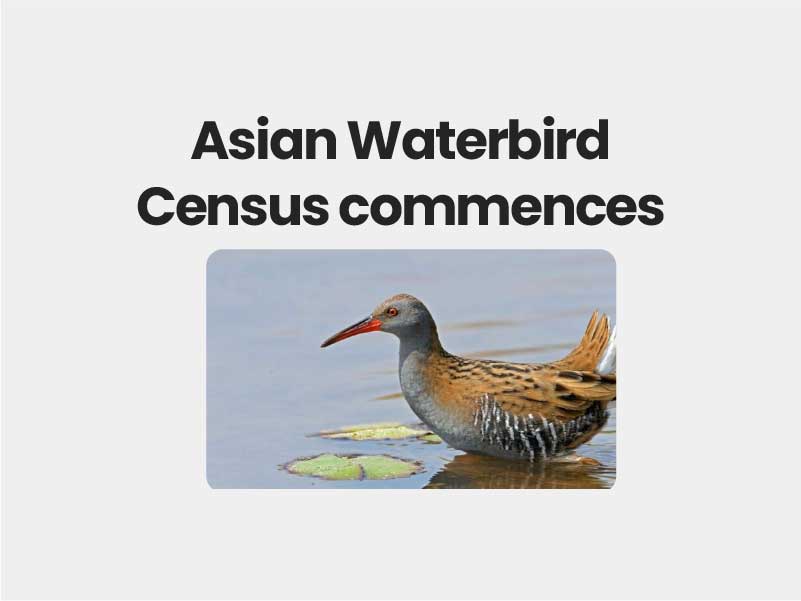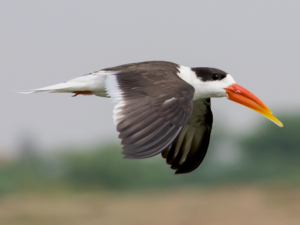Companion@360 → 7 Month programme to sharpen your writing skills → REGISTER NOW

Asian Waterbird Census commences in A.P
Two day Asian Waterbird Census 2020 commenced in Andhra Pradesh on Tuesday under the aegis of experts from the Bombay Natural History Society (BNHS), covering at least two dozen sites, including Coringa Wildlife Sanctuary, Kolleru Lake and Krishna Sanctuary. This citizen science programme is the Asian Waterbird Census (AWC). The AWC is an integral part of the global waterbird monitoring programme, the International Waterbird Census (IWC), coordinated by Wetlands International.
- It runs in parallel with other regional programmes of the International Waterbird Census in Africa, Europe, West Asia, the Neotropics and the Caribbean.
- The AWC was initiated in 1987 in the Indian subcontinent and since has grown rapidly to cover major region of Asia, from Afghanistan eastwards to Japan, Southeast Asia and Australasia. The census, thus covers the entire East Asian – Australasian Flyway and a large part of the Central Asian Flyway.
The Asian Waterbird Census commences has the following objectives:
- To obtain information on an annual basis of waterbird populations at wetlands in the region during the non-breeding period of most species (January), as a basis for evaluation of sites and monitoring of populations
- to monitor on an annual basis the status and condition of wetlands
- to encourage greater interest in waterbirds and wetlands amongst citizens
Till date, more than 6,100 sites of 27 countries have been covered with active participation of thousands of volunteers. The information collected is available to a wide range of government agencies and non-government organizations and contributes to conservation activities from the local to global level, including:
- raising awareness of waterbirds and waterbird conservation issues;
- raising awareness of waterbirds and waterbird conservation issues;
- supporting local conservation activities at wetlands;
- the Ramsar Convention on Wetlands, in identifying and monitoring wetlands of international importance;
- the Convention on Migratory Species (CMS), by monitoring the status of migratory waterbirds and their habitats;
- the Convention on Biological Diversity‘s (CBD) goal in conservation and sustainable use of biodiversity;
- implementation of the East Asian-Australasian Flyway Partnership Initiative (EAAFP) and Central Asian Flyway Action Plan through monitoring important and Flyway Network sites;
- BirdLife International’s Important Bird Area (IBA) Programme;
- IUCN/BirdLife International’s Global Species Programme (Red List);
- Wetlands International’s Waterbird Population Estimates programme.
Key Findings:
- BNHS Assistant Director P. Sathiyaselvam, S. Siva Kumar and BNHS Andhra Pradesh coordinator K. Mrutyunjaya Rao trained amateur birdwatchers on Tuesday on technical aspects of the bird census and challenges, enabling them to conduct the task on their own.
- Dr. Sathiyaselvam, who had previously explored the avian diversity in the Godavari estuary, has presented a demonstration on the 90 species of birds sighted in the Godavari estuary and finalised 12 sites being covered in the census.
- “There is a need of more birdwatchers in the State, as their critical inputs on the wetlands and waterbirds will help design the conservation plans of the respective sites in future,” said Dr. Sathiyaselvam.
- On the endangered Indian Skimmer, Dr. Sathiyaselvam admitted that more study was still required to establish that the species breeds on the Kakinada coast, which supports a great number of Indian Skimmer.
- In Godavari estuary, the Kumbabhisekham mudflat, the wetland opposite the Coromandel industrial area and other Important Bird Areas (IBAs) are being covered.
- The birdwatchers from Visakhapatnam, Rajamahendravaram and Kakinada have been roped into the census in the Godavari estuary.
- In Kolleru Lake and Krishna sanctuaries, the forest department employees are conducting the census.
The Bombay Natural History Society (BNHS):
- A pan-India wildlife research organization, has been promoting the cause of nature conservation since 1883.
- Conservation of nature, primarily biological diversity through action based on research, education and public awareness.
- Premier independent scientific organization with a broad based constituency, excelling in the conservation of threatened species and habitats.
Summaries of all AWC counts are updated annually on our interactive and publicly accessible International Waterbird Census website. They are accessible as national/regional totals and species totals. All sites covered by AWC participants in the past three decades have been represented as an interactive AWC site network map.

